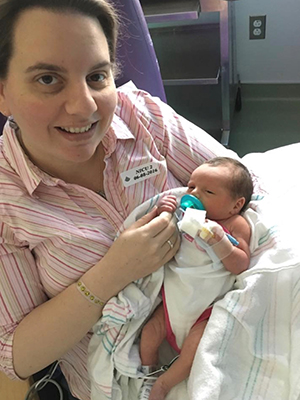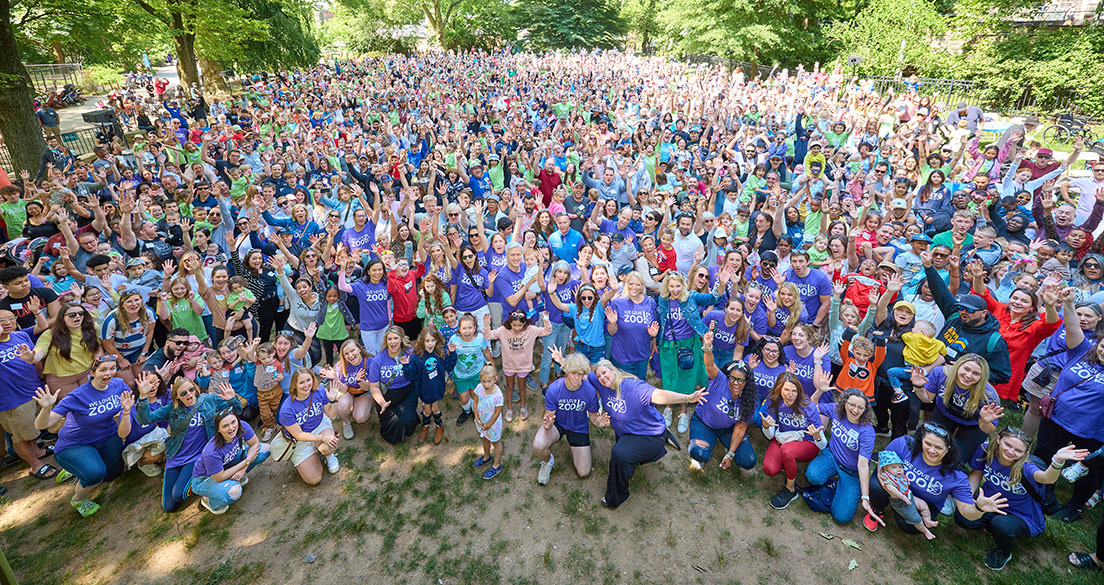Driving Medical Research Breakthroughs
Driving Medical Research Breakthroughs
The tiniest patients: Operating inside the womb
Maternal-fetal surgeons can already remove deadly tumors, unblock clogged aortas, and treat spinal abnormalities in utero. What’s coming next may be even more dramatic.

Lynlee Boemer, now 7, underwent surgery in utero to remove a tumor. The procedure required the expertise of more than 20 practitioners, including specialists in maternal-fetal surgery and pediatric anesthesiology.
Courtesy Maggie Boemer
By Stacy Weiner, Senior Staff Writer
June 29, 2023
Sixteen weeks into Maggie Boemer’s pregnancy, she went for what she thought would be a routine checkup. At one point, though, the ultrasound technician suddenly turned silent. “Then she said, ‘I need to get the doctor,’” recalls the Texas mother of three.
What the technician had noticed looked almost like another head, but in fact was a massive tumor. Called a sacrococcygeal teratoma, it occurs in roughly 1 in 35,000 to 40,000 live births.

Courtesy Maggie Boemer
“We were completely devastated,” says Boemer.
Boemer and her husband desperately wanted to save their child. That meant only one possible option: Removing the tumor before it further threatened the fetus, including by straining its tiny heart.
The couple learned that providers at Texas Children’s Hospital in Houston had performed a similar procedure seven years earlier. After extensive tests and discussions — and as the fetus’s heart was beginning to shut down — the team prepared to operate. That was 23 weeks into the pregnancy.
On the day of the surgery, more than 20 providers participated, including two surgeons, maternal-fetal specialists, several nurses, a pediatric cardiologist, and a pediatric anesthesiologist. They cut open Boemer’s abdomen and drew out the fetus’s lower body to access the hard-to-reach tumor. After they successfully excised nearly all of the mass, they carefully slid the fetus back into place. Then they sutured the uterus, working hard to ensure a seal tight enough to last as it expanded during the rest of the pregnancy.
After 13 weeks of bedrest, Boemer delivered Lynlee via cesarian section, and when the baby was eight days old, surgeons removed the remainder of the tumor.
Now, seven years later, Lynlee, who just finished first grade, is happily dancing ballet and jazz thanks to a medical field that did not even exist 50 years ago.
Maternal-fetal surgery was initiated to save fetuses expected to perish before birth. Since then, it has expanded to include those likely to die in infancy or to experience severe disabilities unless treated in utero.
Maternal-fetal surgeons — who usually train for nearly a decade after medical school — have numerous interventions in their medical armament.
They can drain excess fluid from around fetal lungs, remove fibrous bands that strangle tiny limbs, and open a dangerously narrow fetal aorta. They can address serious risks that ensue when a fetus’s diaphragm develops abnormally. And they can repair shared blood vessels that cause one twin to rob its sibling of an adequate blood supply.
All these procedures are technically complex. Surgeons must operate on a fetus that may be no bigger than an orange, work to protect the placenta, and infuse fluids to replace those that escape the amniotic sac. What’s more, they must avoid the serious danger of triggering preterm labor.
This relatively young specialty has already undergone rapid growth. In 2005, the North American Fetal Therapy Network (NAFTNet) — which provides support to fetal centers, promotes cooperation between them, and fosters related research — launched with just seven member institutions. Today it counts 46, many at academic medical centers.
Oluyinka Olutoye, MD, PhD, now surgeon-in-chief at Nationwide Children’s Hospital in Columbus, Ohio, describes the field’s attraction. “It is a privilege to go into the recesses of the human body to help a fetus. There is a sense of awe. The womb feels almost like a sacred place,” says Olutoye, who operated on Maggie and Lynlee.
But recent developments in technology, science, and public policy — not to mention some long-standing ethical issues — bring both significant questions and exciting possibilities. Those include how to balance risks and benefits for two patients simultaneously and whether recent advances in gene editing will further expand the growing field.
A field is born — and grows
In 1969, as a surgical intern at Massachusetts General Hospital, Michael Harrison, MD, had a dramatic insight: Surgery on newborns was sometimes doomed to fail because a condition had progressed too far before birth. Surgeons instead needed to attempt repairs in utero.
In 1981, after conducting extensive research on monkeys and sheep, Harrison’s team at the University of California, San Francisco (UCSF) performed the first fetal surgery in the United States, unblocking a dangerously obstructed urinary tract. Soon, they and pioneers elsewhere were performing a handful of other procedures.
Today, maternal-fetal experts can provide more than a dozen surgeries to save and improve the lives of fetuses. Children’s Hospital of Philadelphia (CHOP) has performed more than 2,500 such surgeries since 1995.
“Seeing all this is extraordinarily rewarding,” says N. Scott Adzick, MD, who worked with Harrison at UCSF and is the founder and director of CHOP’s fetal center.

Courtesy Richard D. Wood, Jr. Center for Fetal Diagnosis and Treatment at the Children’s Hospital of Philadelphia
Among the most common procedures are those performed to correct extreme spina bifida anomalies — when the fetal spinal column does not close properly, leaving nerves exposed and causing other serious problems. Early intervention matters. Children who receive the repair prenatally are twice as likely to be walking by age 2½ than those who receive it after birth, and less than half as likely to need fluid drained from their brains.
It’s not simple to perform such procedures in utero, but in some ways the uterus is an ideal environment, experts say. “The mom is the lungs and the kidneys,” making artificial support for those functions unnecessary, explains Ramesha Papanna, MD, MPH, NAFTNet president and a surgeon at UTHealth Houston and Children’s Memorial Hermann. “The mother is the best ICU.”
Over the years, advances in the field have made some procedures easier and many safer.
In one major development, most procedures no longer require large incisions. Instead, they need only a small opening to insert a tiny camera and surgical instruments.
These improvements mean surgeries are safer for the fetus, says Papanna. “In 2008, the survival rate for fetuses was 60% at best. Now, for most procedures, it’s 80% to 90%.”
Minimally invasive procedures mean surgeries are safer for the birthing person too. And that second patient is a major focus in maternal-fetal surgery. “We take the obligation to the mother very seriously,” says Olutoye. “This is one of the few fields where you could lose two patients in one operation.”
Difficult decisions
For a patient deciding whether to undergo maternal-fetal surgery — and the providers who help make that highly fraught decision — a number of issues arise.
For one, the risks and benefits for both the fetus and the birthing person must be assessed — not just for surgery but for alternative options. Those include doing nothing (which could lead to the pregnancy’s natural termination), abortion (where legal), and surgery after birth (if feasible).
Before providers share options with patients, they often confer extensively with each other, says Megan Allyse, PhD, an associate professor of biomedical ethics at Mayo Clinic in Jacksonville, Florida.
“We don’t want to say we may be able to help if it turns out we can’t, so teams work hard to try to present a unified message about feasible options. It would be incredibly stressful for patients to go through all the back-and-forth,” she says.
To help guide decisions, groups like the International Fetal Medicine and Surgery Society and the American College of Obstetricians and Gynecologists provide recommendations on such issues as informed consent and protecting clinical research participants.
Ultimately, there are limits to what’s feasible. “We want to do everything in our power, but some fetal problems just cannot be fixed,” says Adzick.
What’s more, “If there are maternal health issues such as hypertension or diabetes, even if the mother wants to proceed, we just won’t do it. We always say no if warranted.”
At her hospital, Allyse serves on a special board focused on fetuses with particularly rare conditions that make decisions even more complicated. In those cases, the group — which includes ethicists and social workers, among other experts — provides the clinical team with recommendations as well as a tailored list of issues to consider.
Experts note that when talking with patients, it’s essential to describe the road that lies beyond surgery. “Caring for a child with severe disabilities is complicated and can test the limits of human capacity,” says Papanna. “Are they aware of what’s coming in one month, five months, even decades?”
These considerations require in-depth, sensitive patient-provider conversations. “A very complex, intricate human connection happens in this field,” says Papanna. “We are constantly faced with considering how we can best help this patient, this whole family.”
But even if surgery makes sense, social and economic variables mean treatment is sometimes not equitably available. “Sometimes, sadly, it’s as simple as the person not being able to take time off work for everything involved,” says Allyse.
And the U.S. Supreme Court Dobbs decision overturning the right to abortion may sometimes narrow options, experts note.
“When a patient has a fetus with major health issues, previously care teams might say, ‘Your baby will have significant issues, but there’s a surgery that could possibly make its life easier. That’s one of several options available to you,’” says Allyse. “But that’s very different from now when they sometimes have to say, ‘That baby must stay in your uterus, and all we can offer you is this surgery.’ That’s an entirely different landscape.”
New frontiers
Looking ahead, Papanna sees advances he considers potential game-changers for the field. “We are at an inflection point in multiple ways,” says the NAFTNet president.
Among these are the possibility of even tinier surgical instruments, robotic devices better equipped to navigate the uterus, and tethering fetal membranes to the uterus to help prevent preterm labor.
But experts say the most exciting advances lie in moving beyond treating structural anomalies to addressing issues at the molecular level — and devising precision treatments specific to each fetus.
Already, two such techniques are undergoing human trials: one using enzymes and another that employs stem cells.
The enzyme approach attempts to treat conditions like Pompe disease in which the failure to produce crucial enzymes damages muscles and vital organs. So far, researchers have successfully treated three fetuses by injecting the necessary enzyme, says Tippi MacKenzie, MD, a lead author of a December 2022 article on the first such surgery and a UCSF surgeon.
The stem-cell approach focuses on alpha thalassemia major, a genetic blood disorder that causes deadly anemia. Previously, physicians had only two options. One — not a cure — was to treat the condition in utero with blood transfusions. The other was a post-birth stem-cell transplant — which is curative — but that comes with such risks as transplant rejection.
Now, researchers have begun testing stem cell transplants in utero. “We are injecting the mother’s stem cells into the umbilical cord,” explains MacKenzie. “The main idea is that a fetus is not likely to reject cells from its mother during pregnancy.”
Next up, experts say, could be fetal gene therapy or editing for such conditions as sickle-cell anemia. First, though, those procedures must be tested on animals to forestall any unintended consequences. “We hope to see these used in humans in less than a decade,” says MacKenzie.
Meanwhile, Olutoye is excited by such developments as he also watches his own son pursue maternal-fetal surgery.
“This field is a wonderful choice” of specialty, says Olutoye, who often stays in touch with patients for years. “You met this person when they were basically zero years old and now they’re teens. That’s very gratifying. I still get texts and calls and cards from all over the world from people I met even before their parents did.”